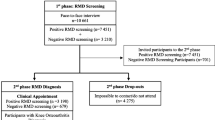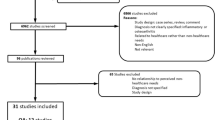Abstract
In developed countries, osteoarthritis (OA) has been among the ten most severe disability diseases in recent years. Approximately, 10% of the world’s population struggle with knee OA symptoms at the age of 60. OA causes significant pain, disability, lifestyle decline, and financial burdens. Therefore, the discussion regarding the treatment of OA is crucial. In this study, we presented the use of scenario and incident models as frameworks, and divide patients into groups by cluster analysis. Subsequently, we identified the key factors of the initial state and analyzed the medical scenarios. Accordingly, we inferred that the characteristics of a patient influence the outcome of treatments, and administering different treatments to patients triggers different outcomes. The method to carry out this study was using cluster analysis and scenario analysis, and the result shows patients with higher effectiveness of improvement while taking supplement treatment, that is glucosamine. Patients should control their weight appropriately, because high BMI will impact the treatment outcome. Patients who exercise frequently have better treatment outcome, the age and gender rarely influence the treatment outcome. The findings of this study can provide beneficial suggestions for hospitals and physicians in adjusting the supply of treatments, improving medical quality, and providing knee OA patients with a way to adopt appropriate treatment.


Similar content being viewed by others
References
World Health Organization (2020) Osteoarthritis. http://www.who.int/chp/topics/rheumatic/en/. Accessed 30 April 2020
DeHaan MN, Guzman J, Bayley MT, Bell MJ (2007) Knee osteoarthritis clinical practice guidelines-how are we doing? J Rheumatol 4(10):2099–2105
National Health Insurance Administration, Ministry of Health and Welfare (2018) Analysis of drug usage 2016, 2017, 2018. https://www.nhi.gov.tw/Content_List.aspx?n=5AA7CAFFF61CB16D&topn=3FC7D09599D25979. Accessed 10 Oct 2021
Maille M, Statler IC, & Chaudron L (2005) An application of FCA to the analysis of aeronautical incidents, In: Ganter B, and Godin R (Eds.) Formal Concept Analysis, Third International Conference, ICFCA 2005, 145-161, Springer Berlin, Germany
Banfield JD, Raftery AE (1993) Model-based Gaussian and non-Gaussian clustering. Biometrics 49:803–821
Gan G, Chaoqun MA, Wu J (2007) Data clustering: theory, algorithm, and application. SIAM, Society for Industrial and Applied Mathematics, Philadelphia, PA
Lequesne M, Mery C, Samson M, Gerard P (1987) Indices of severity for osteoarthristis of the hip and knee. Validation-value in comparison with other assessment tests. Scand J Rheumatol 65:85–89
National Institutes of Health, U.S. Department of Health and Human Services (2020) HEALTH TOPICS/OSTEOARTHRITIS, https://www.niams.nih.gov/health-topics/osteoarthritis/advanced#tab-risk. Accessed 4 May 2020
Bellamy N, Buchanan WW, Goldsmith CH, Campbell J, Stitt LW (1988) Validation study of WOMAC: a health status instrument for measuring clinically important patient relevant outcomes to antirheumatic drug therapy in patients with osteoarthritis of the hip or knee. J Rheumatol 15(12):1833–1840
Han J, Kamber M (2001) Data mining: concepts and techniques. Morgan Kaufmann Publishers, San Francisco
Berkhin P (2006) A survey of clustering data mining techniques. In: Korgan J, Nicholas C, Teboulle M (eds) Grouping multidimensional data-recent advances in clustering. Springer Publishers, Berlin, pp 25–72
Dempster AP, Laird NM, Rubin DB (1977) Maximum likelihood for incomplete data via the EM algorithm. J R Stat Soc B 39:1–38
Hwang JY, Kuo W (2007) Model-based clustering for integrated circuit yield enhancement. Eur J Oper Res 178(1):143–153
Rogers J (2001) Data mining using the EM clustering algorithm on places rated almanac data. http://www.galaxy.gmu.edu/stats/syllabi/inft979/RogersPaper.pdf. Accessed 10 Sept 2008
Reaven GM, Miller RG (1979) An attempt to define the nature of chemical diabetes using a multidimensional analysis. Diabetologia 16(1):17–24
Ristevski B, Loshkovska S, Dzeroski S, Slavkov I (2008) A comparison of validation indices for evaluation of clustering results of DNA microarray data. In: The 2nd Int Conf on Bioinformatics and Biomedical Engineering, 587–591
Legany C, Juhasz S, Babos A (2006) Cluster validity measurement techniques. In: Proc of the 5th WSEAS Int Conf on Artificial Intelligence, Knowledge Engineering and Data Bases, 388–393
Dunn JC (1974) Well separated clusters and optimal fuzzy partitions. J Cybern 4:95–104
Davies DL, Bouldin DW (1979) A cluster separation measure. IEEE Trans Pattern Anal Mach Intell 1(2):95–104
Halkidi M, Vazirgiannis M, Batistakis Y (2000) Quality scheme assessment in the clustering process. In: Proc of the 4th European Conf on Principles of Data Mining and Knowledge Discovery, 265–276
Halkidi M, Vazirgiannis M (2001) Clustering validity assessment: Finding the optimal partitioning of a data set. Proc of ICDM 2001:187–194
Schwartz P (1996) The art of the long view: paths to strategic insight for yourself and your company. Currency Doubleday, New York
Kahn H, Wiener AJ (1967) The Year 2000: a framework for speculation on the next thirty-three years. Macmillan, New York
Porter ME (1985) Competitive advantage: creating and sustaining superior performance. Free Press, New York
Wilson I (2000) From scenario thinking to strategic action. Technol Forecast Soc Chang 65(3):23–29
O’Brien FA (2004) Scenario planning-lessons for practice from teaching and learning. Eur J Oper Res 152:709–722
Shell International (2017) Shell scenarios, modelling and decision making. http://www.shell.com/. Accessed 5 May 2020
Vanston JH Jr, Frisbee WP, Lopreato SC, Poston DL Jr (1977) Alternate scenario planning. Technol Forecast Soc Change 10(1):59–180
Fahey L (2000) Scenario learning. Manag Rev 89(3):29–35
Wack P (1985) Scenarios: uncharted waters ahead. Harv Bus Rev 63(5):73–89
van der Heijden K (1996) Scenarios, the art of strategic conversation. Wiley, London
Axson DA (2018) Scenario Planning: Applying a six-step process to your organization-Guideline. https://www.cpacanada.ca/. Accessed 5 Mar 2021
Centers for Disease Control and Prevention, International Classification of Diseases (2011) Ninth Revision, Clinical Modification (ICD-9-CM), 2011 edition, https://www.cdc.gov/nchs/icd/icd9cm.htm. Accessed 24 March 2019
Hair JF Jr, Anderson RE, Tatham RL, Black WC (1998) Multivariate data analysis, 5th edn. Prentice-Hall, Upper Saddle River, NJ
Brock G, Pihur V, Datta S, and Datta S (2021) clValid: validation of clustering results. https://cran.r-project.org/web/packages/clValid/index.html. Accessed 5 Mar 2021
Der G, Everitt BS (2005) Statistical analysis of medical data using SAS. Chapman and Hall/CRC, New York
Agresti A (2013) Categorical data analysis, 3rd edn. Wiley, Hoboken, NJ
Author information
Authors and Affiliations
Corresponding author
Additional information
Publisher's Note
Springer Nature remains neutral with regard to jurisdictional claims in published maps and institutional affiliations.
Rights and permissions
About this article
Cite this article
Tan, SC., Lai, CL. & Hou, JJ. Scenario analysis on medical treatments of patients with knee osteoarthritis. J Supercomput 78, 10310–10325 (2022). https://doi.org/10.1007/s11227-021-04206-4
Accepted:
Published:
Issue Date:
DOI: https://doi.org/10.1007/s11227-021-04206-4




